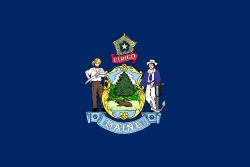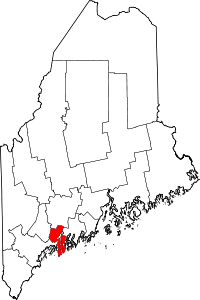Fort Popham

Fort Popham is a coastal defense land battery at the mouth of the Kennebec River in Phippsburg, Maine. It is located in sight of the short-lived Popham Colony and, like the colony, named for George Popham, the colony's leader. During the American Revolution a minor fortification stood on this site; in 1808 the federal government built a small battery derisively known as an "embargo fort" on this location as part of the second system of fortifications that guarded the coast. It remained manned until 1815 and saw minor action during the War of 1812.
Construction of Fort Popham was authorized in 1857 but did not begin until 1861. The fort was built from granite blocks quarried on nearby Fox and Dix islands. It had a 30-foot (9 m)-high wall facing the mouth of the Kennebec River and was built in a crescent shape, measuring approximately 500 feet (150 m) in circumference.
Fort Popham's armament consisted of 36 Rodman guns and some 10 inch Parrott rifles arranged in two tiers of vaulted casements.One of the Rodman guns was donated to the town of Bowdoinham to remember its soldiers who died in the civil war.The cannon is still there.A single Parrott rifle sits near the fort grounds. The back side of Fort Popham was built with a low moated curtain containing a central gate and 20 musket ports.
In 1869 construction at Fort Popham stopped before the fortification was completed. The fort was garrisoned again after additional work was performed during the Spanish-American War and World War I. Construction of Fort Baldwin on the headland above Fort Popham began in 1905 with longer-range guns, which eventually rendered Fort Popham obsolete.
The fort, located two miles (3 km) from popular Popham Beach State Park, is open to the public as Fort Popham State Historic Site. It was added to the National Register of Historic Places as Fort Popham Memorial on October 1, 1969, reference number 69000012.
-

The fort's setting
-

Entrance
-

Interior
References
Further reading
For this fort's role in Jefferson's embargo, see Smith, Joshua M. "Maine's Embargo Forts," Maine History, Vol. 44, No. 2 (April 2009), 143-154.
For this fort's role in the War of 1812, see Burrage, Rev. Henry S. “Captain John Wilson and Some Military Matters in the War of 1812.” Collections and Proceedings of the Maine Historical Society, second series, 10 (1899), 403–429.
External links
- Fort Popham State Historic Site - official site
- "Fort Popham (historical)". Geographic Names Information System. United States Geological Survey. Retrieved 2009-02-13.
- Information and photos about Fort Popham
- Information and photos about Fort Popham

